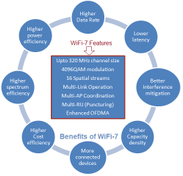Vendors of M2M IoT Products
Explore vendors and resources for Machine-to-Machine (M2M) and Internet of Things (IoT) products, enabling seamless machine communication via the internet.
Showing 20 posts (Page 11 of 13)
Advertisement
Explore vendors and resources for Machine-to-Machine (M2M) and Internet of Things (IoT) products, enabling seamless machine communication via the internet.

Explore the features of the Verizon 5G Home Router (CPE), focusing on the Samsung model, 5G technology, specifications, and network details.

Explore the pros and cons of Visible Light Communication (VLC). Learn about bandwidth, security, interference, and range limitations of VLC technology.

Explore the distinctions between VLC and RF communication. Discover how VLC uses light and RF uses electromagnetic waves for wireless data transfer. Understand their applications and advantages.

Explore the fundamental differences between VLC (Visible Light Communication) and WiFi, including features, advantages, and disadvantages of each wireless technology.

Explore the VORTAC navigation system, which combines VOR and TACAN for providing bearing and distance information to both civilian and military aircraft.

Explore the Weightless standard, designed for low-cost, long-battery-life IoT devices using TV white space, including frame structure, specifications, and protocol stack.

Explore Wi-Fi 7's transmit spectral mask, critical for minimizing interference and ensuring efficient spectrum use with wider channels and higher-order modulation.

Understand non-signaling and signaling tests for Wi-Fi 7 devices. Learn their key characteristics, metrics, and applications in ensuring compliance and performance.

Explore the pros and cons of Wi-Fi 7 (IEEE 802.11be), including its high speeds, reduced latency, increased complexity, and power consumption.

Learn about Wi-Fi Direct technology, which enables direct Wi-Fi connections between devices without an access point. Explore its benefits and applications.
Explore Wi-SUN frequency bands used globally, including USA, Canada, Australia, Japan, Europe, and India. Find key parameters and regulatory domains.

Wi-SUN is a secure, optimized mesh network promoted by the Wi-SUN Alliance for smart utility and smart city applications. It ensures interoperability between vendors using IEEE 802.15.4g.

Explore the distinctions between WiDi and WiFi, understanding their purposes, functionalities, and applications in wireless communication and display technology.
Explore the similarities and differences between WiFi 7 (802.11be) and WiFi 8 (802.11bn), focusing on data rates, features, and target applications.

Explore the advantages and disadvantages of WiFi extenders, including improved performance, easy setup, and extended range, as well as potential drawbacks such as cost and placement issues.

Explore the evolution of WiFi technology, from the original 802.11b to the latest WiFi 6 (802.11ax). Compare speeds, range, and key features across all generations.

Explore the pros and cons of WiFi HaLow (IEEE 802.11ah), including its low power consumption, extended range, and drawbacks like limited global standardization.

Explore a comprehensive list of WiFi router manufacturers and vendors, covering WLAN standards, specifications, and key features.
Explaining the difference between WiFi signal strengths of -70dB and -50dBm, including definitions of dB and dBm and their significance in wireless communication.
Advertisement